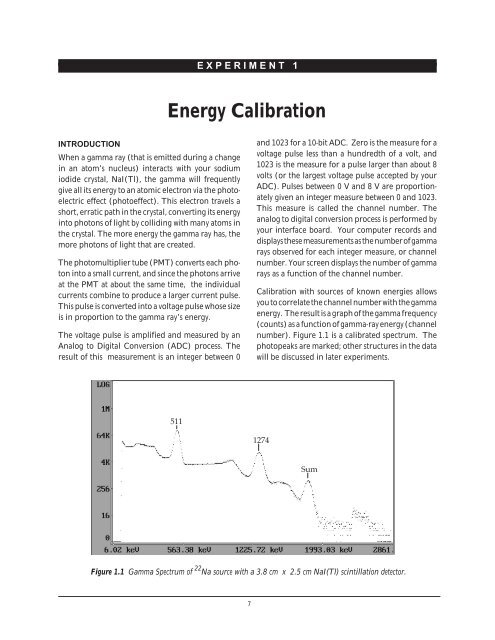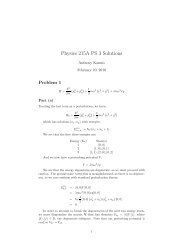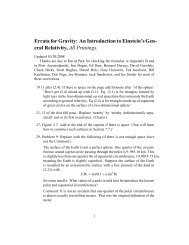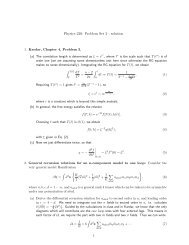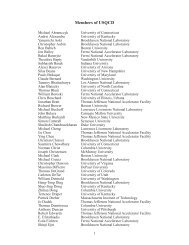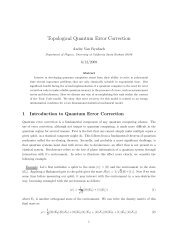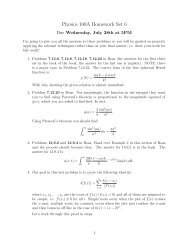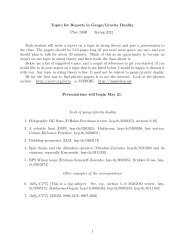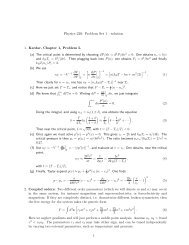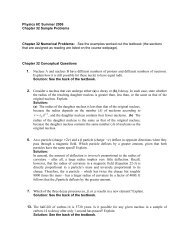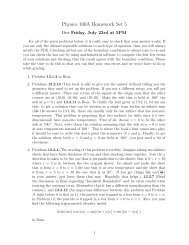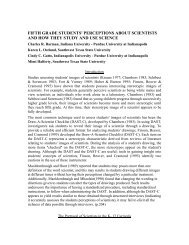Nuclear Spectroscopy
Nuclear Spectroscopy
Nuclear Spectroscopy
You also want an ePaper? Increase the reach of your titles
YUMPU automatically turns print PDFs into web optimized ePapers that Google loves.
E X P E R I M E N T 1<br />
Energy Calibration<br />
INTRODUCTION<br />
When a gamma ray (that is emitted during a change<br />
in an atom’s nucleus) interacts with your sodium<br />
iodide crystal, NaI(Tl), the gamma will frequently<br />
give all its energy to an atomic electron via the photoelectric<br />
effect (photoeffect). This electron travels a<br />
short, erratic path in the crystal, converting its energy<br />
into photons of light by colliding with many atoms in<br />
the crystal. The more energy the gamma ray has, the<br />
more photons of light that are created.<br />
The photomultiplier tube (PMT) converts each photon<br />
into a small current, and since the photons arrive<br />
at the PMT at about the same time, the individual<br />
currents combine to produce a larger current pulse.<br />
This pulse is converted into a voltage pulse whose size<br />
is in proportion to the gamma ray’s energy.<br />
The voltage pulse is amplified and measured by an<br />
Analog to Digital Conversion (ADC) process. The<br />
result of this measurement is an integer between 0<br />
and 1023 for a 10-bit ADC. Zero is the measure for a<br />
voltage pulse less than a hundredth of a volt, and<br />
1023 is the measure for a pulse larger than about 8<br />
volts (or the largest voltage pulse accepted by your<br />
ADC). Pulses between 0 V and 8 V are proportionately<br />
given an integer measure between 0 and 1023.<br />
This measure is called the channel number. The<br />
analog to digital conversion process is performed by<br />
your interface board. Your computer records and<br />
displays these measurements as the number of gamma<br />
rays observed for each integer measure, or channel<br />
number. Your screen displays the number of gamma<br />
rays as a function of the channel number.<br />
Calibration with sources of known energies allows<br />
you to correlate the channel number with the gamma<br />
energy. The result is a graph of the gamma frequency<br />
(counts) as a function of gamma-ray energy (channel<br />
number). Figure 1.1 is a calibrated spectrum. The<br />
photopeaks are marked; other structures in the data<br />
will be discussed in later experiments.<br />
511<br />
1274<br />
Sum<br />
Figure 1.1 Gamma Spectrum of 22 Na source with a 3.8 cm x 2.5 cm NaI(Tl) scintillation detector.<br />
7


